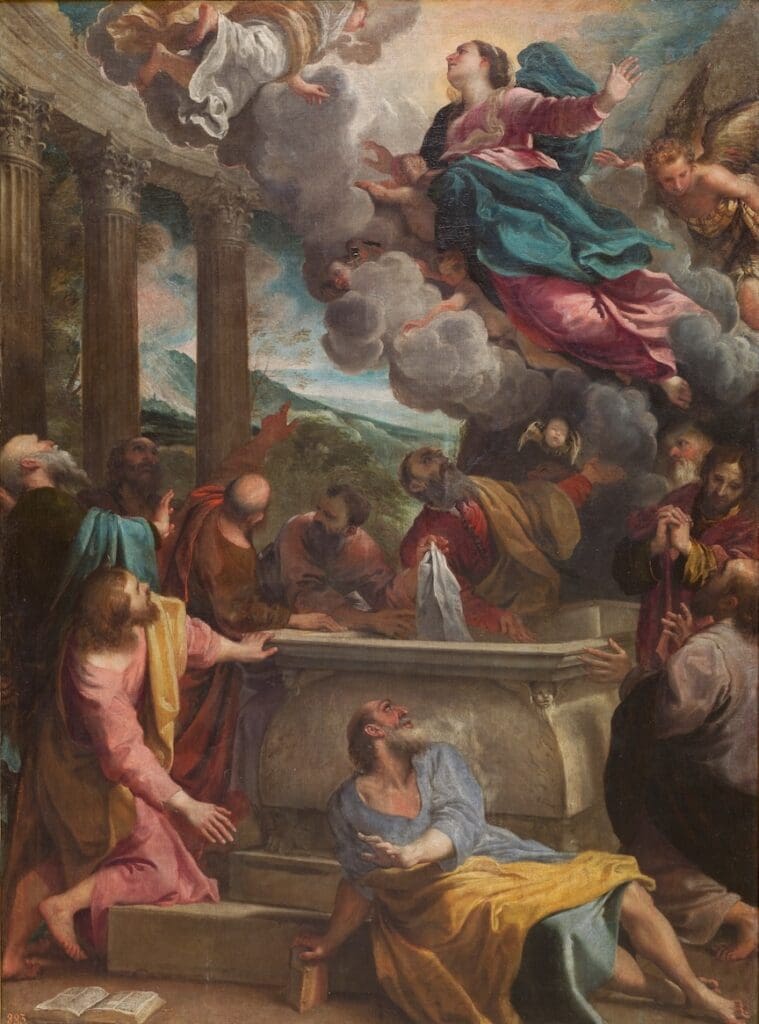The dogma of Mary’s Assumption, celebrated on August 15, teaches that the Lord’s Mother was taken into Heaven, body and soul, since no decay should touch the body of her who bore the Messiah. Christians believe “in the resurrection of the body.” And the doctrine of the Assumption merely asserts God’s acknowledgment of Mary’s worthiness to anticipate (from the earth-bound perspective of human time) the fullness of salvation as both Mother of Christ and Mother of the Church.
This has both a Christological and an ecclesiological dimension. Mary’s reward is in virtue of her divine maternity. It likewise points toward the resurrection of the dead, which is the hope of the whole Church. Mary’s privileges are promises. What God has done for her, He is willing to do for all members of His Son’s Church.
Mary’s experience is unique only from the temporal point of view. The experience of salvation (her Immaculate Conception) and the experience of resurrection (her Assumption) are possible for all believers. The difference is that her possession of these gifts is present and real, while ours is in the future.
In the Risen Christ and the Assumed Virgin, both bodily present in Heaven, we behold the fullness of redeemed humanity. Male and female, the New Adam and the New Eve, stand as signs of hope for us all.
While the doctrine of Mary’s bodily Assumption was only defined as a dogma by the Venerable Pope Pius XII in 1950, he didn’t create a new teaching but proclaimed what had always been held from time immemorial.
The reason, prompted by the Holy Spirit, may be that modern man is in great need of hope, given the tragic wars of the twentieth century, with their unspeakable assaults on human life and dignity. This Solemnity is truly a celebration of hope reminding us that God rewards faithfulness.
Mary’s life of joyful service has been taken up into the risen life of Heaven. Like a good mother, as she waits for us to reach the finish line, she prays for us. Like good children, we try to imitate her example, hoping to be found worthy of that eternal home where God is “all in all.” (1 Corinthians 15:28)

For anyone who finds this dogma difficult to accept, I offer two responses.
First, if Elijah could be taken up to Heaven in a whirlwind, without dying (see 2 Kings 2), why not the Mother of the Word Incarnate? Indeed, there is even a pious tradition among some Jews that Moses was also assumed into Heaven.
St. John Henry Cardinal Newman, very humanly and tenderly suggests:
One reason for believing in Our Lady’s Assumption is that her Divine Son loved her too much to let her body remain in the grave. A second reason – that now before us – is this, that she was not only dear to the Lord as a mother is dear to a son, but also that she was so transcendently holy, so full, so overflowing with grace. Adam and Eve were created upright and sinless, and had a large measure of God’s grace bestowed upon them; and, in consequence, their bodies would never have crumbled into dust, had they not sinned; upon which it was said to them, “Dust thou art, and unto dust thou shalt return.” If Eve, the beautiful daughter of God, never would have become dust and ashes unless she had sinned, shall we not say that Mary, having never sinned, retained the gift which Eve by sinning lost? . . .Was her comeliness to be turned into corruption, and her fine gold to become dim, without reason assigned? Impossible. (“Sancta Dei Genetrix”)
Second, every major Protestant Reformer accepted this event as self-evident. So meaningful a doctrine was this to Martin Luther that his burial chamber in the Wittenberg church, on whose door he had posted his ninety-five theses, was adorned with Peter Vischer’s 1521 sculpture of the Coronation of the Virgin, with a Latin inscription for the feast of the Assumption: “The Queen, whose feast this is, is taken to her throne on high, escorted by the angelic choirs, and the Son Himself places His Mother in the high heavens.”
Finally, the sainted Cardinal Newman resorts to simple logic:
if her body was not taken into Heaven, where is it? how comes it that it is hidden from us? why do we not hear of her tomb as being here or there? why are not pilgrimages made to it? why are not relics producible of her, as of the saints in general? Is it not even a natural instinct which makes us reverent towards the places where our dead are buried? We bury our great men honourably. . . .When Our Lord’s body was taken down from the Cross, He was placed in an honourable tomb. Such too had been the honour already paid to St. John Baptist, his tomb being spoken of by St. Mark as generally known. Christians from the earliest times went from other countries to Jerusalem to see the holy places.
From all this, the future Doctor of the Church drew the obvious conclusion:
Now, if there was anyone who more than all would be preciously taken care of, it would be Our Lady. Why then do we hear nothing of the Blessed Virgin’s body and its separate relics? Why is she thus the hidden Rose? Is it conceivable that they who had been so reverent and careful of the bodies of the saints and martyrs should neglect her – her who was the Queen of Martyrs and the Queen of Saints, who was the very Mother of Our Lord? It is impossible. Why then is she thus the hidden Rose? Plainly because that sacred body is in Heaven, not on earth. (“Rosa Mystica”)










